I don’t know if it is because here in the Tetons we often have a lot of flat-ish terrain to cover before we really start skinning uphill, but I’ve really become a fan of a large range of motion in the cuffs of my AT boots. I often ski wearing Dynafit TLT5 Performance boots, which have a huge ROM in the cuff and a great walk mode, but can lack a bit when your are driving a bigger ski (like a BD Megawatt) or really want to shred and haul ass. I usually look to a beefier boot, the Black Diamond Quadrant, when I want to ski more aggressively, or drive bigger skis in the backcountry. They have a decent walk-mode, which gets better with use, but I found myself wanting more ROM in the upper cuff and removed some material in the lower shell, which increased the ROM and reduced overall resistance when in walk-mode quite a bit.
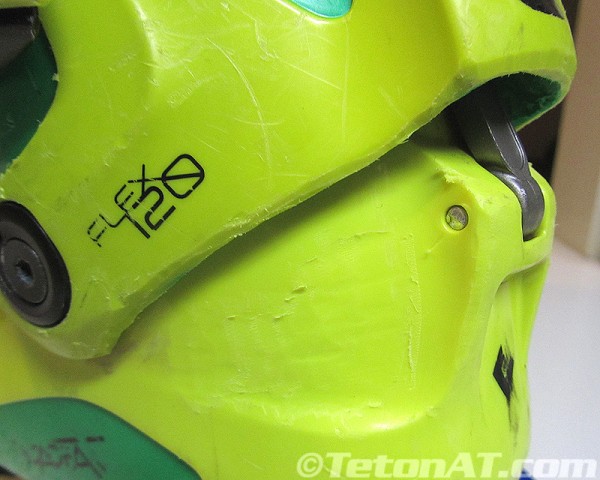
Click all photos for larger image.
The photo above shows most of the work and I used a dremmel tool to grind down some of the plastic in multiple areas of the boot, like the plastic on the outside of the heel and rear spine area on the lower shell, and the bottom and inside of the back of the cuff and around the inside rivet. Obviously, if you put a stiff liner, like an Intuition Power Wrap, into a boot who’s shell has a lot of ROM, you are not really gonna benefit from the shell’s walk-mode. So, that is something to consider before you start hacking away at your. And to note, doing stuff like this to your boots will probably void the warranty, but the Quadrant is pretty burly and I’ve never had anything break on mine. Here are some more photos.
As you can see, I removed 1/8″ to 1/4″ of the plastic from the bottom of the cuff. I used the tapered area as a guide. I didn’t feel much need to remove plastic by the cant rivet, so I left that area alone. I also did some grinding on the outside of the heel area on the lower cuff. The first photo kind of shows this better.
This shows the area by the walk-mode spine and inside of the cuff. On the spine on the lower shell, I felt that rounding off the corners helped loosen things up, but be careful grinding where the walk-mode bar attaches to the boot, as this is an important place that you don’t want to loose strength. Removing the canting rivet helps to gain access to the inside lower section of the cuff, and it helps to look down from inside of the boot to see where things are binding up as the cuff moves backward.
I found that there was still some resistance in cuff movement after all the grinding above, and due to the shapes and curves involved, I pinpointed it to the plastic by inside cuff rivet. It was hard to do, and maybe a dremmel wasn’t the correct tool for the job, but I was able to grind off some of the green material, which seemed to loosen things up and allow the upper cuff to go through it’s full ROM a bit smoother.
Still looking to increase the efficiency of the walk-mode, I also cut off some of the plastic on the front of the lower shell, so the buckles wouldn’t hit it as the cuff moves backward. I just used a utility knife to cut the material away, and it was a little hard to tell how much to take away so the overlap part of the upper cuff didn’t fall behind the lower shell when the buckles are tightened. How it is now, and depending on how tight the cuff closure is, it occasionally falls behind the lower shell, but it’s not that big of a deal when walking/skinning, and to just realign things before you clamp everything down when you are ready to ski.
The grinds and cuts seem to have helped a lot in increasing the ROM and reduce resistance/friction between the cuff and lower shell. Some say that the efficient movement of a boot’s walk-mode, as well as a large range of motion, can often trump the weight savings of a lighter boot, and to some extend I agree.

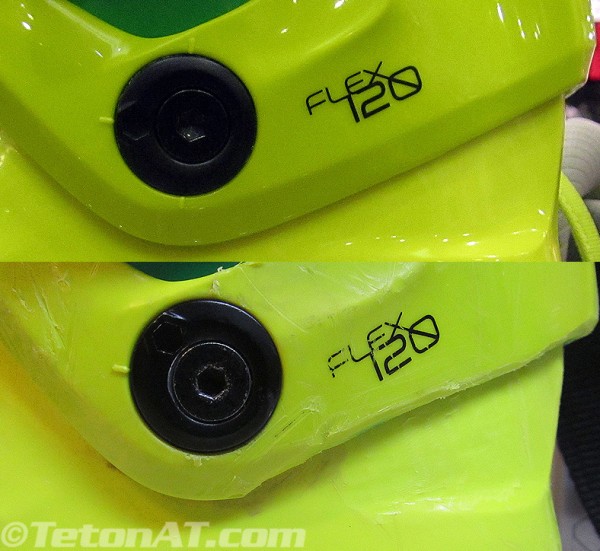
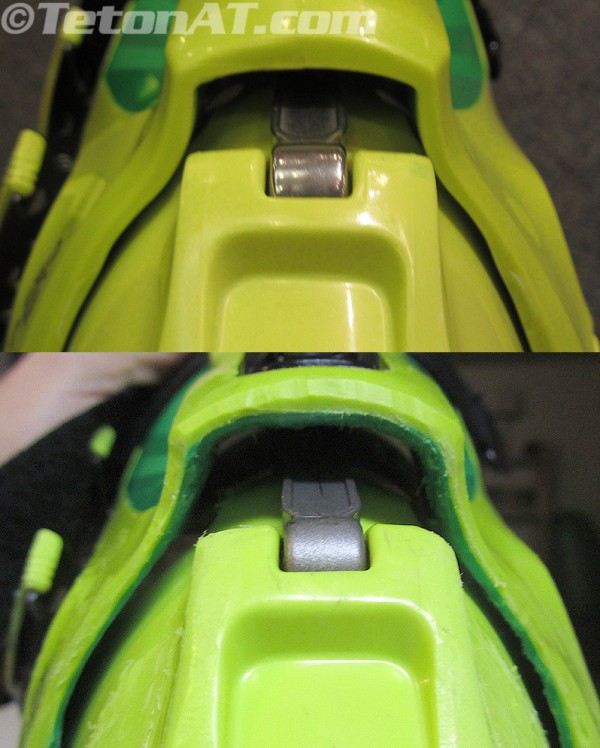
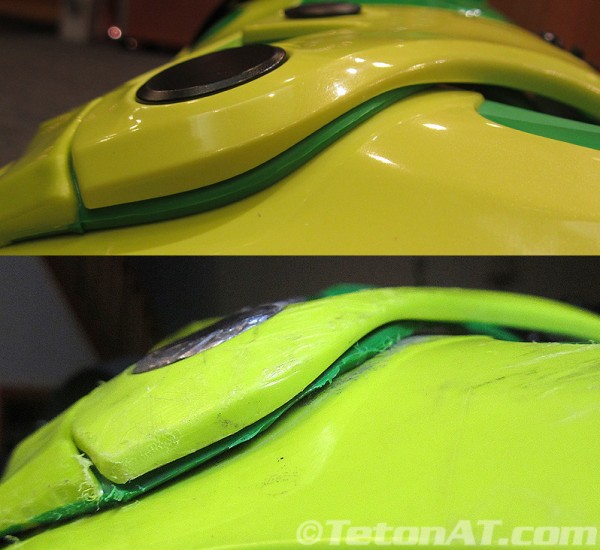
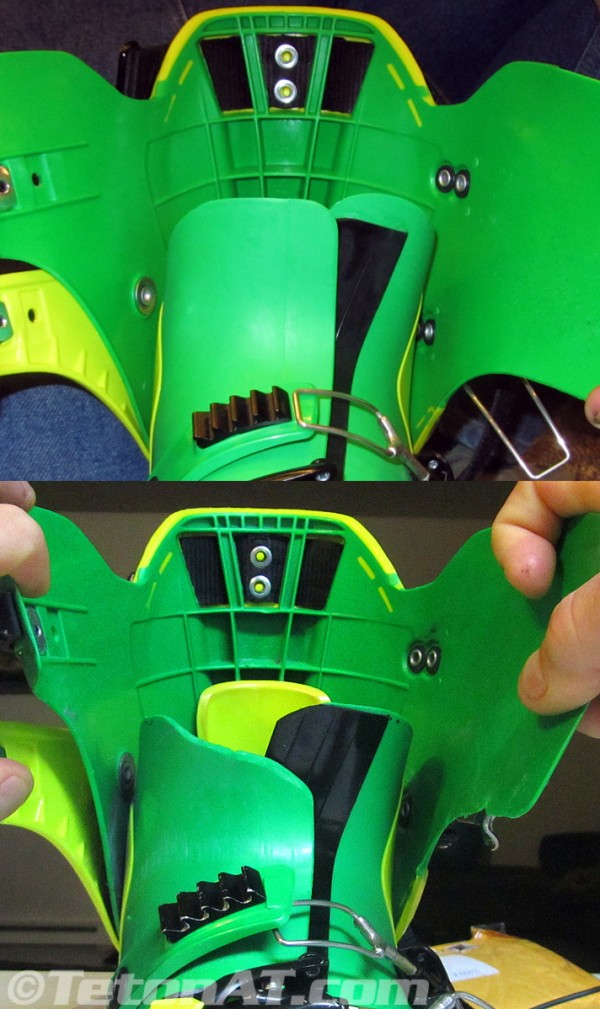
sick,
thank you Steve
Finally, the truth be told. Its all about the ROM. Can’t tell you how much it pains me to watch folks take baby steps in their encumbered cuffs. Its all about the STRIDE! Duh. Thx for showing BD what true ROM can be attained and what a boot gamechanger it will be for the tour. Give me the overlap construction and give me the ROM!
What liners are you running in those RS?
like !
dave..intuition alpine wrap.
http://www.intuitionliners.com/alpine_page.htm
Any loss in stiffness after the mods? I ground out my quadrants with a dremmel to get some more rearward range, but I didn’t remove nearly as much plastic as you did.
Hey Steve!
Does this affect the performance in ski-mode at all? Looks like a good mod!
-josh
diggler/josh…i don’t really feel any loss in stiffness. the only downside i’m finding is dealing with the overlap section of the cuff when it doesn’t fall into place correctly with the lower shell.
Jsut got a pair from of these from ebay and I am having some fit issues (seems to be the norm with these boots).
My foot is a 285-290, pretty normal width, but it puts me between shell sizes with many boots. I wear a Dynafit TLT5 mountain in 290, which fits me perfectly out of the box, no heat molding. Also threw in some Scarpa/Intuition liners and they baked perfectly in there with good toe space and total hold down in the heel area.
My Quadrants are 29.0 and the stock liner felt too short and too loose in back. I baked them with toe caps and everything to get more room. Now it still is too short, and not much tighter around the heel. The entire liner moves up and down in the boot. Stinks, since 290 should be plenty long for my feet, but doesn’t even come close. There is air between shell and liner in the heel area and it moves up and down in the back no matter how tightly I buckle everything.
The shell seems far too large for the other liners I tried as well, although those are both meant for the much lower volume TLT5, so no surprise. I don’t want to bake the Scarpa liners again just to find out that they don’t work in that large shell.
I wonder if it is worth to get another set of Intiutions to fill the boot volume properly. Right now the stock and any other liner are so poor in that area that I am about to sell the boots before wasting another $200 on liners only to find out I should have just bought another pair of Dynafit boots instead. the Quadrant shell size is not too large – pretty normal space in the back without liners, so going down a size would only make things worse, given the liners are too short already at 290.
I’d love to break out the dremel to do the mods suggested on this page, but it appears the boot will only fit people with fat short feet and with a really fat liner that actually will hold in the shell. Is the “alpine wrap” Intuition thicker than the Scarpa Speed Pro liner (made by Intuition)?
http://www.scarpa.com/scarpa/products/SKI/SKI-LINERS/p_10605-500
peter…sizing is all about shell fit. if you have more than 2 fingers behind your heel when shell fitting…it is probably getting to be too big.
i think an intuition liner would help…a lot. the alpine wrap is 12mm of materiel all around the liner. it’s hard to tell what the thickness is of those scarpa liners…but they are definitely not as think at the toe.
After a few more try-ons, I think the boot simply is too large – the BD sizing for 290 states US 12, which is a full size above the Italian-lasted boots I have (Scarpa F1 and TLT5). The BD liner outside the shell is actually plenty large, so the toe-cramming I feel when inside is just due to the shell being too large and me moving around in there. Taking a closer look at shell space, there’s more than an inch, definitely more than two fingers, so I am probably not going to get this sorted even with a fat intuition liner.
I suppose I should have trusted the BD size chart, which is quite different from other brands. Problem is where I live, there’s no place you can try these things on. Good news – they were a good deal and I learned about BD sizing. Sure was looking forward to taking the dremel to this boot 🙂